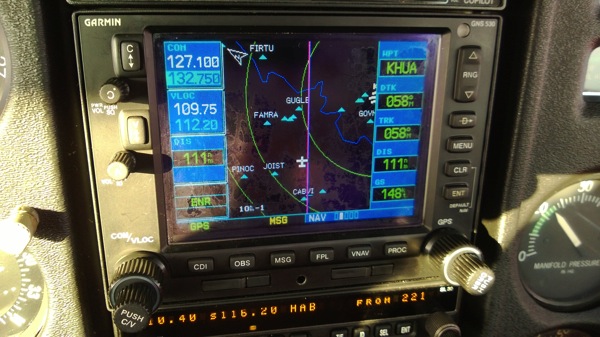Recently I had the opportunity to fly down to Louisiana to see my mom, grandmother, and uncles. This was an easy trip: straight-line, it’s 411 miles from airport to airport. It took me 3:12 to get down there and 3:00 to get back. Why the difference? In a word, wind. In the northern hemisphere (and, more particularly, in the US, since that’s where I’m flying), prevailing winds tend to follow predictable patterns: west-to-east for much of the country, and (in general) onshore in coastal areas. The strength and direction of winds aloft vary, of course. For example, the definition of a frontal boundary (the line demarcating where a cold or warm front actually starts or ends) is an area where the wind suddenly changes direction and speed. It’s generally true that you’ll face headwinds when flying from east to west and tailwinds when flying from west to east, but the strength and direction of the winds can change quite a bit as you move across different types of terrain, through different weather systems, and so on.

astute readers can figure out exactly where I was when this picture was taken
In the picture above, the “GS” number in the lower right shows that I had a groundspeed of 148 knots. Since one knot is 1.14 statute miles/hour, that’s just over 170mph. That seems pretty good, considering that it’s more than double the speed limit on any of the roads that link Huntsville and Alexandria (and triple, or more, the speed limit for the West Monroe-Alexandria leg). The 128kts average groundspeed I had going westbound still equates to 147mph. Although a 20-knot difference is nothing to sneeze at, the practical impact is that it saved me… exactly 12 minutes, mostly because the winds kept changing.
That brings up the question of fuel usage. Every powered airplane has a set of performance charts that show you, for a given altitude and power setting, how fast you can go in still air (and remember, airspeed isn’t the same as groundspeed; that’s a topic for another post) and how much fuel you’ll burn while doing so. Book fuel burn for the Cessna 182P is between 12 and 14 gallons per hour, depending on your altitude and power setting. Most rental aircraft are rented “wet”; that is, the hourly rental rate includes gas and oil. In a rental, you therefore have an incentive to configure the engine for best speed even if you burn a couple more gph. When it’s your airplane (or when it’s a “dry” rental) you’re paying for the fuel, so you get to choose: would you rather burn more gph or get there a little later?
The correct answer is “it depends.” Aviation gasoline costs anywhere from $5 to $7/gallon in the US. (Why so much? Why the variance? Those are topics for another post too.) Suppose I can cruise at 130kts for 12gph, or 150kts for 15gph. That extra speed is going to cost me, let’s say, $18/hour. For a 411nm trip, that means I can get there in about 3 hours 9 minutes for just under 38 gallons (so, call it $228). On the other hand, at 150kts I could get there in only 2 hours 44 minutes, but it would cost me 41 gallons of fuel, or $246. In my case, since I was renting a plane, I went pedal to the metal, adjusting the engine for max speed rather than best fuel efficiency.
Now, this is an oversimplification, of course. It ignores the time spent climbing and descending (you burn more fuel in the climb, and less in a descent, but not enough to equal what you burned climbing), it assumes that ATC doesn’t reroute you anyplace inconvenient, and so on; it’s a good enough estimate for our purposes.
Let’s compare, now, the cost/mile of flying versus driving. I drive a 2005 Nissan Altima that gets 30mpg on the highway. Bing Maps says the fastest road route is 514 statute miles. So, that’ll cost me about $60 in gas, as opposed to $384 for the airplane rental. I’m leaving out all the other fixed and variable costs of the car; if I wanted this to be more precise I’d compare the cost of driving a rental car from here to there, but who would do that if they didn’t have to? Anyway, flying is considerably more expensive until you figure the time savings. Bing calls this an 8-hour trip, assuming no stops for fuel, food, or bathroom breaks. I can make it in a hair over 3 in the plane, though I have to take my own food. As with the car, that price stays the same whether I fly solo or with passengers (or cargo, such as the excellent banana pudding I brought back– thanks, Mom!)
Clearly I could come up with a business rationale that values my time at what Dell bills customers for it, or what I bill for it on standalone projects, but the right way to think about it, I think, is that the time I gain is priceless: being able to get to see family and friends, or attend important events, or just get out of town for a trip, is important, and the airplane gives me the flexibility to go farther, faster, more often than I could in a car, for considerably less money (usually) than it would take to fly commercial.
For another time: does it make sense to spend more money to rent or buy a faster airplane? It depends.


